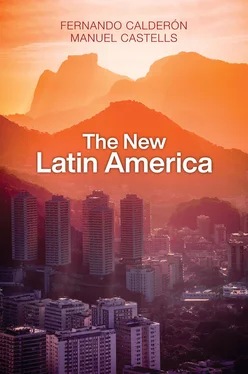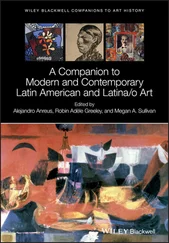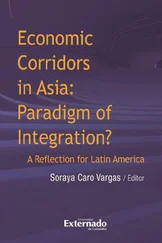The crises of both neoliberalism and neo-developmentalism must be seen in a historical perspective. The understanding of the new Latin America should start from the premise that looking at history is a requirement for the recovery of social meaning in a context of dramatic changes like those discussed in this book.
In a moment of multidimensional global restructuring, multinational companies are being substantially reorganized at the productive, financial, and commercial levels. Latin America has always been defined by global powers and companies as a territory for the extraction of commodities and natural resources; currently this mainly means lithium, copper, iron, rare and precious minerals, agricultural products, forestry, oil, gas, and coca leaves, among others. However, the networks of economic power that connect extractive territories to global developments driven by companies in sharp competition (as in the Chinese, German, Australian, and Japanese companies caught in disputes over lithium) are still in flux. These conflicts have an increasing influence on the dynamics of crisis and political confrontation in the region. This can be seen in the breaking of the agreement between the Bolivian government and German companies, meant to allow the latter to extract lithium, a break that resulted from the criticisms and protests that took place in the second half of 2019 in the Potosí Department in Bolivia.
In political terms, threats to liberal democracy are also related to profound changes in the international arena, particularly given the United States’ aggressive policy toward Latin America under the Trump administration. This policy appears to represent a return to the Cold War era, when conspiracies and misinformation were the norm and contributed to the deterioration of democracy in the region. Thus, new crises and conflicts lead to fragmentation, with military forces once again taking center stage. The more socio-institutional processes and agreements fail, the greater the power and influence of the military will become. This phenomenon is furthered by the resurgence of hyper-ideologization, which has found a perfect vehicle for expression in social media.
The crisis has resulted in various social outcomes. On the one hand, in Chile, citizens have demanded democratic participation in local governments as well as a new constitution and a more inclusive economic model. On the other hand, in Bolivia, a process of social polarization has taken place, despite all the positive changes made by the government led by the Movimiento al Socialismo (MAS). After the November 2019 electoral mess, an authoritarian regime, with significant representation of the military and police forces, seized power. This democratic regression in Bolivia was facilitated by the territorial polarization that, once again, split the country, dividing Amazonian from Andean regions and rural from urban. At the time of writing, we observe a breakdown in the social fabric, which will be difficult to reconstitute in the future.
The crises of the neoliberal and neo-developmental models are part of a multidimensional global crisis. This is leading to the rise of a new set of social conflicts, which are modifying daily life as well as the social bond itself. The outcomes of these crises are uncertain not least because of the frailty of institutions and their incapacity to provide social support. Hostility permeates inter-personal relations and cultures.
What kind of new model could be implemented given the region’s now irreversible integration in the global economy? The answers to this question ultimately depend on the social conflicts and political arrangements in each country. But to understand both the region’s recent past and its future prospects, we have to consider other factors that are distinct from class interests and economic policies, which are only windows that open onto a much more complex reality.
This is particularly the case with the political awakening of indigenous peoples, and the social-racist reaction of elites against these peoples’ coming to power through democratic elections, as in Ecuador and, more significantly, in Bolivia. The latter country enjoyed steady economic growth and modernization for over a decade, together with a substantial improvement in living conditions and reduction of poverty. Yet the charismatic leadership of Evo Morales – an indigenous, peasant trade unionist – and the election of indigenous people, particularly “cholas,” to key state positions were not tolerated by the white elite, especially in the pro-business province of Santa Cruz. This hostility ultimately led to a military coup that took advantage of the mistakes made by Morales, including his attempt to stay in power by bureaucratic maneuvers that may (or may not) have included electoral fraud. A similar socio-cultural conflict underlies the social explosion in Ecuador, where the rural indigenous populations have been suffering under the austerity policies imposed by the traditional oligarchy with the support of the armed forces and foreign powers. We should note as well the tensions surging in Chile among the Mapuche and among the Indian minorities in Mexico. Guatemala is constantly shaken by white elites’ violent attempts to subdue the marginalized 70 percent of the population of indigenous descent.
However, to understand processes of social and political change like the ones we are now witnessing in Latin America, we need to move beyond the study of social structures and institutions. We need to identify the actors responsible for social change. We have spent considerable time and effort studying social movements and forms of social protest. And in this book we have identified the main social actors involved in these processes, actors who are at the forefront of the protests that have shaken multiple countries in the last wave of street mobilizations. They are made up of youth first and foremost, usually student movements, including secondary education students, but more broadly young people in all social conditions, whether they are students or not. In this volume, we explain the profound transformations that have shaped new generations in Latin American, generations that are more educated, better informed, and empowered by their communicative autonomy in digital networks. In every instance, youth have initiated protests, and they have been those who sustain it when harsh repression comes. They are fearless, having overcome the terror that their parents experienced under bloody dictatorships. Moreover, they often revolt on behalf of their grandparents, as was explicitly the case in Chile when they tried repeatedly to attack the high-rise building of the Costanera Center in Providencia, because it was the symbol of the distress of the elderly without pensions, who frequently used that building to commit suicide. A vivid notion of intergenerational solidarity informed the protests, as when protestors demanded access to free decent education because their parents had gone into debt to pay for it.
Women were also powerful actors who sought to overthrow patriarchy and end violence against women, defending their rights over their own bodies and their personal freedom. The intensity of women’s mobilizations in Argentina, for instance, was a decisive factor in political change in that country, but it was also present in other countries, particularly in Brazil, Bolivia, Chile, and Mexico.
While workers’ demands and unions were significant in the mobilizations, particularly in Argentina where Peronist trade unions are a major force, the new social movements brought together very different actors, including urban social movements, environmentalists, animal rights defenders, ethnic minorities, LGBT activists, human rights advocates, and artists. A common banner united these disparate actors: dignity.
Dignity was the word used as the rallying cry in most of these movements, as it has been in the majority of networked social movements taking place around the world during the last decade, from Spain to Hong Kong and from New York to Chile. In this context, dignity means something other than claiming the right to a decent livelihood. It is a demand for the right to be treated as dignified human beings, with respect from elites who despise what they see as an ignorant populace and refuse to be accountable to those who elect and pay them.
Читать дальше












